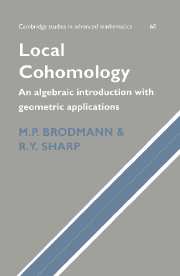Book contents
- Frontmatter
- Contents
- Dedication
- Preface
- Notation and conventions
- 1 The local cohomology functors
- 2 Torsion modules and ideal transforms
- 3 The Mayer-Vietoris Sequence
- 4 Change of rings
- 5 Other approaches
- 6 Fundamental vanishing theorems
- 7 Artinian local cohomology modules
- 8 The Lichtenbaum-Hartshorne Theorem
- 9 The Annihilator and Finiteness Theorems
- 10 Matlis duality
- 11 Local duality
- 12 Foundations in the graded case
- 13 Graded versions of basic theorems
- 14 Links with projective varieties
- 15 Castelnuovo regularity
- 16 Bounds of diagonal type
- 17 Hilbert polynomials
- 18 Applications to reductions of ideals
- 19 Connectivity in algebraic varieties
- 20 Links with sheaf cohomology
- Bibliography
- Index
9 - The Annihilator and Finiteness Theorems
Published online by Cambridge University Press: 04 May 2010
- Frontmatter
- Contents
- Dedication
- Preface
- Notation and conventions
- 1 The local cohomology functors
- 2 Torsion modules and ideal transforms
- 3 The Mayer-Vietoris Sequence
- 4 Change of rings
- 5 Other approaches
- 6 Fundamental vanishing theorems
- 7 Artinian local cohomology modules
- 8 The Lichtenbaum-Hartshorne Theorem
- 9 The Annihilator and Finiteness Theorems
- 10 Matlis duality
- 11 Local duality
- 12 Foundations in the graded case
- 13 Graded versions of basic theorems
- 14 Links with projective varieties
- 15 Castelnuovo regularity
- 16 Bounds of diagonal type
- 17 Hilbert polynomials
- 18 Applications to reductions of ideals
- 19 Connectivity in algebraic varieties
- 20 Links with sheaf cohomology
- Bibliography
- Index
Summary
There have been several examples earlier in this book of non-finitely generated local cohomology modules of finitely generated modules: for example, in 6.1.6, and also in 7.3.3, we saw that if (R,m) is local, and N is a non-zero, finitely generated R-module of dimension n > 0, then is not finitely generated. Since, being isomorphic to a submodule of N, is certainly finitely generated, it becomes of interest to identify the least integer i for which is not finitely generated. This integer is referred to as the finiteness dimension fm(N) of N relative to m. Our work in this chapter on Grothendieck's Finiteness Theorem will enable us to see that, in this situation, and under mild restrictions on R,
However, our approach will not restrict attention to the case where the ideal with respect to which local cohomology is calculated is the maximal ideal of a local ring; also, the approach we shall take will show that questions about such finiteness dimensions are intimately related to questions about precisely which ideals annihilate local cohomology modules. We shall, in fact, establish Grothendieck's Finiteness Theorem as a special case of Faltings’ Annihilator Theorem, which is concerned with the following question: given a second ideal b of R such that b ⊆ a, and given a finitely generated R-module M, is there a greatest integer i for which is annihilated by some power of b, and, if so, what is it?
Finiteness dimensions
Our first two results will provide motivation for the formal introduction of the concept of finiteness dimension. Let M be a finitely generated R-module.
- Type
- Chapter
- Information
- Local CohomologyAn Algebraic Introduction with Geometric Applications, pp. 152 - 178Publisher: Cambridge University PressPrint publication year: 1998



